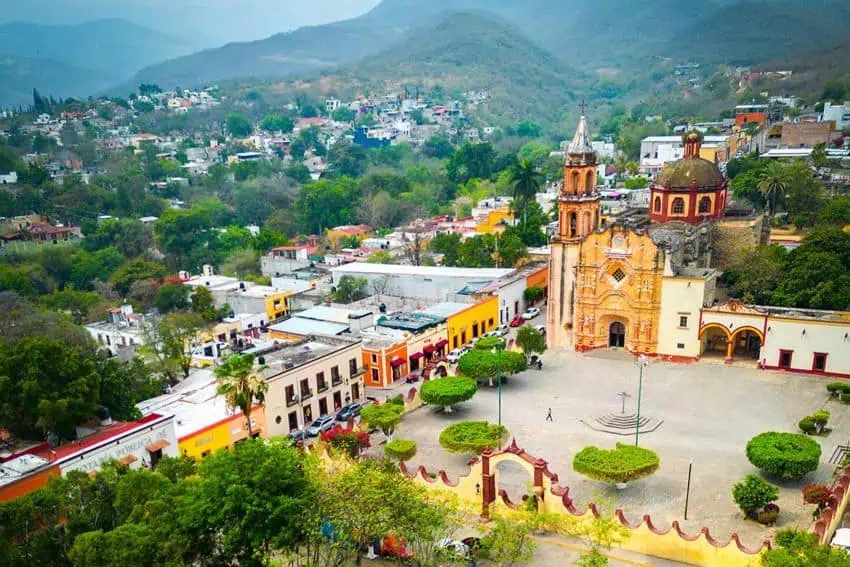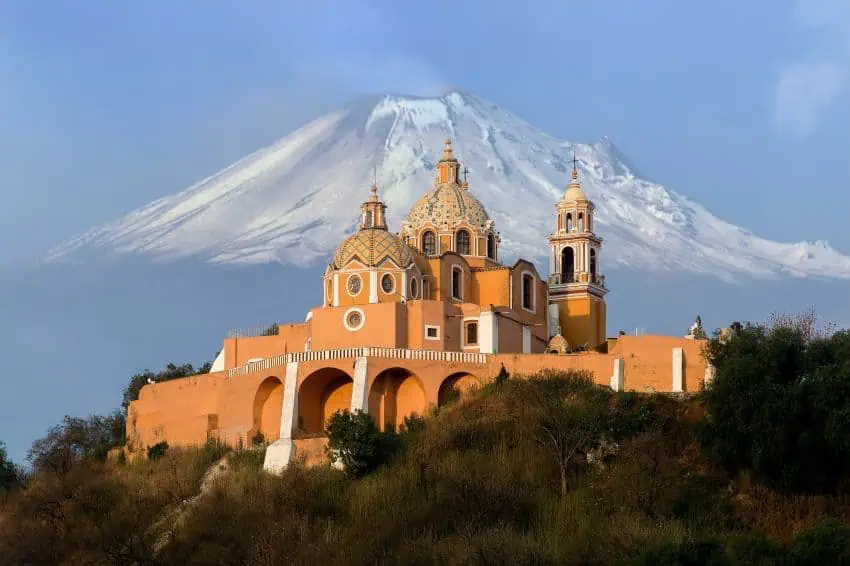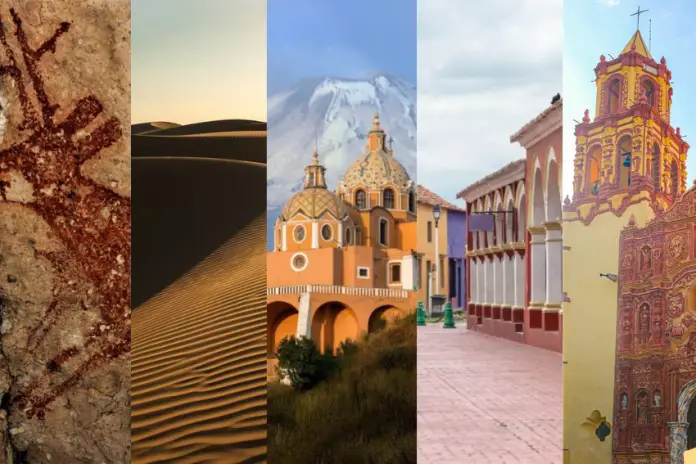From pre-Columbian archeological sites to colonial cities and natural wonders, Mexico is ranked seventh for the number of sites on the UNESCO World Heritage List. With a whopping 27 cultural sites, six natural sites and two mixed sites, a marvel is always right around the corner in Mexico.
Perhaps you are already familiar with some of these places, like the pre-Hispanic city of Chichen Itzá in Yucatán, the Historical Center in Mexico City or the expat paradise of San Miguel de Allende in Guanajuato. Perhaps you’re anxious to discover places off the beaten path with fewer tourists but the same historical value.

Whether you’re looking for natural sites, cultural destinations or a combination of both natural and cultural significance, here are five lesser-known UNESCO sites in Mexico to satisfy the interests of any travel enthusiast.
1. Tlacotalpan
A river port town 72 km south of the city of Veracruz, Tlacotalpan “is an exceptionally well-preserved Spanish colonial river port,” according to UNESCO.
Preserving its original checkerboard-patterned urban plan, this little colonial town from the 16th century on the banks of the Papaloapan River is the perfect place to experience vernacular Caribbean traditions. Many of the traditional houses adjacent to the river, which feature vivid colors and exuberant decorations, have preserved their original form, scale, adornments, colors and even furniture. Public and private gardens throughout the town also feature ancient trees.
Tlacotalpan is famous for being the birthplace of Mexican singer and composer Agustín Lara, author of renowned Mexican songs like “María Bonita” or “Solamente Una Vez.”

A visit to this jewel of a town should include the Municipal Palace, the Main Park, the San Cristóbal Church and the Agustín Lara Museum. Visitors can also take a boat tour through part of the Papaloapan River for bird watching and visit the historic neighboring town of Alvarado. Companies like Viator offer guided tours in English to both towns.
How to get there? The Veracruz Bus Station in the city of Veracruz has daily departures to Tlacotalpan on the ADO and TRV lines approximately every 45 minutes.
2. The Great Mural Art of Sierra de San Francisco
Deep in a canyon in the Baja California Peninsula are America’s oldest cave paintings. Dating back to approximately 100 B.C. to A.D. 1300 (between 7,000 and 12,000 years old), their remote location and the region’s dry climate have allowed the paintings to survive in remarkable condition for thousands of years. UNESCO has said this is “one of the most outstanding collections of rock paintings in the world.”
Depicting various human and animal figures, including marine and terrestrial fauna, the Great Murals are attributed to the Cochimí people, who lived relatively isolated from continental influences. The paintings, which number in the hundreds, have red, black, white and yellow colors.

Little is known of the Cochimí, who rapidly disappeared after contact with the Jesuit missionaries from Europe in the 16th century.
Baja Cave Art Excursions offers guided tours in English to the caves.
How to get there? Due to the difficult access to the caves from the nearest towns (San Ignacio and El Vizcaíno), Mexico’s Culture Ministry recommends booking an expedition with a specialized tourist company. The trek on foot or donkey to the caves may take up to five hours from the Santa Teresa Canyon, the only authorized camping site in the area.
3. 16th Century Monasteries on the Slopes of Popocatépetl
At the conjunction of Morelos, Puebla and Tlaxcala states, on the slopes of Mexico’s most active volcano, stand 15 monasteries in an excellent state of conservation. They were built by the first missionaries in the Americas: the Franciscans, Dominicans and Augustinians.

The monasteries are located in different Magic Towns and archeological zones (including famous sites like Tepoztlán and Cholula). These buildings are evidence of an original architectural style created for the purposes of evangelization and as venues for cultural exchange between Europe and the Indigenous communities. These monasteries are particularly special for their innovative architectural features: they feature open spaces and large atriums that did not exist in similar Europe churches.
The influence of this style can be seen across Mexico and beyond its borders in different colonial buildings.
According to UNESCO, the monasteries’ original elements are perfectly preserved, making them a “complete representation of an actual 16th century Monastery.”
How to get there? Since the monasteries are scattered across different places in three states, the Culture Ministry has created a map and guide to the Route of the Monasteries.
4. Pinacate Desert

Located in the northern state of Sonora, the El Pinacate and Gran Desierto de Altar Biosphere Reserve are part of the four great North American deserts along with the Chihuahuan Desert, the Mojave Desert and the Great Basin Desert.
The natural protected area of the Pinacate Desert is a relatively undisturbed desert that encompasses two landscapes across 714,566 hectares. To the east, it is home to a volcanic area of around 200,000 hectares, boasting extensive black and red lava flows and desert pavement. UNESCO claims that the most visually striking feature is the group of 10 enormous, almost perfectly circular steam blast craters.
To the west is the Gran Altar Desert, North America’s largest field of sand dunes. reaching up to 200 meters high. These dunes are the only Erg dunes (areas with a large accumulation of sand) in North America.
Pinacate Tours organizes different camping experiences in the several areas of the desert.
How to get there? The main access is at kilometer 52 of Highway 8 Puerto Peñasco-Sonoyta, 3.5 hours from the city of Phoenix, Arizona in the United States.
5. Franciscan Missions in the Sierra Gorda of Querétaro
View this post on Instagram
The Franciscan Missions were built between 1750 and 1760 as part of the evangelization of the Spanish colonial period in Querétaro. These missions facilitated the work of Christian missionaries in California, Arizona and Texas.
UNESCO notes that the richly decorated church façades are a clear example of the fusion of cultures between the missionaries and the natives. “They are a testimony of the cultural coexistence between two societies and the natural environment,” it says.
The Franciscan Missions have been remarkably preserved in the mountainous region of the Sierra Gorda. They include the Mission of Santiago de Jalpan, Our Lady of the Light of Tancoyol, San Miguel Concá, Santa María del Agua de Landa and San Francisco de Asís del Valle de Tilaco.
Some church interiors include Indigenous motifs including images of jaguars, eagles and Indigenous peoples themselves.
Promotur Querétaro offers different tours to explore all five missions. This experience can be coupled with a tour of the Historic Center of the city of Querétaro, also a UNESCO World Heritage Site.
How to get there? The missions are scattered around the state. They are all easily accessible by road. You can follow this guide to explore them at your own pace.
Gabriela Solis is a Mexican lawyer turned full-time writer. She was born and raised in Guadalajara and covers business, culture, lifestyle and travel for Mexico News Daily. You can follow her lifestyle blog Dunas y Palmeras.
